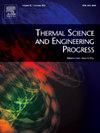R1233zd(E)小直径通道冷凝换热与压降的实验分析与建模
IF 5.1
3区 工程技术
Q2 ENERGY & FUELS
引用次数: 0
摘要
建议使用R1234yf、R1234ze(E)和氢氯氟烃R1233zd(E)等氢氟烯烃作为制冷和空调应用中氢氟烃的替代品。特别是R1233zd(E),由于其全球变暖潜势值要低得多,但饱和度曲线相似,因此被建议替代R123和R245fa。在有机朗肯循环中,R1233zd(E)也被用作R245fa的替代品。在本研究中,研究了R1233zd(E)在内径小于4 mm的小通道中的冷凝过程。在40°C饱和温度和质量通量30 kg m-2 s-1至400 kg m-2 s-1范围内进行了冷凝实验。因此,本研究对于直接朗肯循环和反蒸汽压缩循环冷凝器的设计都具有特殊的意义。采用小直径通道是为了减少制冷剂充注量。本研究特别侧重于在降低质量通量,即100 kg m-2 s-1及以下发生的凝结。这些质量通量的实验研究相对较少,尽管考虑到预测工具在这些工作条件下不太准确,它们具有重要的相关性。目前的实验活动,除了测量传热系数和两相摩擦压降外,还包括在3.38 mm内径管内流动模式的可视化。检测到的流型被用来评估一个改进的流型图,并讨论了三种半经验模型的预测。由于R1233zd(E)为低压制冷剂,压降较高,因此冷凝换热性能也受到摩擦引起的饱和温度降的影响。因此,首先在相同的质量通量下与其他流体进行比较,然后在适当考虑压降的操作条件下进行比较。本文章由计算机程序翻译,如有差异,请以英文原文为准。
Experimental analysis and modelling of R1233zd(E) condensation heat transfer and pressure drop in small diameter channels
Hydrofluoroolefins such as R1234yf, R1234ze(E) and hydrochlorofluoroolefin R1233zd(E) were suggested as replacements for hydrofluorocarbons in refrigeration and air-conditioning applications. In particular, R1233zd(E) has been indicated for the substitution of R123 and R245fa, since it displays a much lower value of global warming potential but a similar saturation curve. R1233zd(E) is also adopted as a replacement for R245fa in organic Rankine cycles. In the present study the condensation process of R1233zd(E) has been investigated in small channels with internal diameter lower than 4 mm. Condensation experiments have been conducted at 40 °C saturation temperature and mass flux ranging from 30 kg m-2 s-1 to 400 kg m-2 s-1. Therefore, this study holds particular significance for the design of condensers both in direct Rankine cycles and inverse vapour compression cycles. The adoption of channels with small diameter is intended for reducing the refrigerant charge. The present study is particularly focused onto condensation occurring at reduced mass flux, at 100 kg m-2 s-1 and below. Experimental investigations at these mass fluxes are relatively scarce, despite their significant relevance considering that predicting tools are less accurate at these working conditions. The present experimental activity, besides the measurement of the heat transfer coefficients and two-phase frictional pressure drop, includes the visualization of the flow patterns, in a 3.38 mm inner diameter tube. The detected flow regimes have been used to assess a modified flow pattern map and discuss the predictions of three semi-empirical models. Since R1233zd(E) is a low-pressure refrigerant displaying high pressure drop, the condensation heat transfer performance is also affected by the saturation temperature drop due to friction. Therefore, the comparison with other fluids is carried out first at the same mass flux and then at operating conditions that properly account for the pressure drop.
求助全文
通过发布文献求助,成功后即可免费获取论文全文。
去求助
来源期刊

Thermal Science and Engineering Progress
Chemical Engineering-Fluid Flow and Transfer Processes
CiteScore
7.20
自引率
10.40%
发文量
327
审稿时长
41 days
期刊介绍:
Thermal Science and Engineering Progress (TSEP) publishes original, high-quality research articles that span activities ranging from fundamental scientific research and discussion of the more controversial thermodynamic theories, to developments in thermal engineering that are in many instances examples of the way scientists and engineers are addressing the challenges facing a growing population – smart cities and global warming – maximising thermodynamic efficiencies and minimising all heat losses. It is intended that these will be of current relevance and interest to industry, academia and other practitioners. It is evident that many specialised journals in thermal and, to some extent, in fluid disciplines tend to focus on topics that can be classified as fundamental in nature, or are ‘applied’ and near-market. Thermal Science and Engineering Progress will bridge the gap between these two areas, allowing authors to make an easy choice, should they or a journal editor feel that their papers are ‘out of scope’ when considering other journals. The range of topics covered by Thermal Science and Engineering Progress addresses the rapid rate of development being made in thermal transfer processes as they affect traditional fields, and important growth in the topical research areas of aerospace, thermal biological and medical systems, electronics and nano-technologies, renewable energy systems, food production (including agriculture), and the need to minimise man-made thermal impacts on climate change. Review articles on appropriate topics for TSEP are encouraged, although until TSEP is fully established, these will be limited in number. Before submitting such articles, please contact one of the Editors, or a member of the Editorial Advisory Board with an outline of your proposal and your expertise in the area of your review.
 求助内容:
求助内容: 应助结果提醒方式:
应助结果提醒方式:


